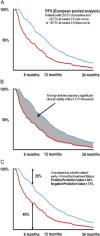Circulating tumor cells in breast cancer
- PMID: 26809472
- PMCID: PMC5528978
- DOI: 10.1016/j.molonc.2016.01.001
Circulating tumor cells in breast cancer
Abstract
Over the past decade, technically reliable circulating tumor cell (CTC) detection methods allowed the collection of large datasets of CTC counts in cancer patients. These data can be used either as a dynamic prognostic biomarker or as tumor material for "liquid biopsy". Breast cancer appears to be the cancer type in which CTC have been the most extensively studied so far, with level-of-evidence-1 studies supporting the clinical validity of CTC count in both early and metastatic stage. This review summarizes and discusses the clinical results obtained in breast cancer patients, the issues faced by the molecular characterization of CTC and the biological findings about cancer biology and metastasis that were obtained from CTC.
Keywords: Breast cancer; Circulating tumor cells; Metastatic process; Prognostic markers.
Copyright © 2016 The Authors. Published by Elsevier B.V. All rights reserved.
Figures

References
-
- Alix-Panabières, C. , Pantel, K. , 2015. Liquid biopsy in cancer patients: advances in capturing viable CTCs for functional studies using the EPISPOT assay. Expert Rev. Mol. Diagn. 15, 1411–1417. 10.1586/14737159.2015.1091729 - DOI - PubMed
-
- Alix-Panabières, C. , Pantel, K. , 2013. Real-time liquid biopsy: circulating tumor cells versus circulating tumor DNA. Ann. Transl. Med. 1, 18 10.3978/j.issn.2305-5839.2013.06.02 - DOI - PMC - PubMed
-
- Alunni‐Fabbroni, M. , Müller, V. , Fehm, T. , Janni, W. , Rack, B. , 2014. Monitoring in metastatic breast cancer: is imaging outdated in the era of circulating tumor cells?. Breast Care (Basel). 9, 16–21. 10.1159/000360438 - DOI - PMC - PubMed
-
- Armstrong, A.J. , Marengo, M.S. , Oltean, S. , Kemeny, G. , Bitting, R.L. , Turnbull, J.D. , Herold, C.I. , Marcom, P.K. , George, D.J. , Garcia-Blanco, M.A. , 2011. Circulating tumor cells from patients with advanced prostate and breast cancer display both epithelial and mesenchymal markers. Mol. Cancer Res. 9, 997–1007. 10.1158/1541-7786.MCR-10-0490 - DOI - PMC - PubMed
-
- Autebert, J. , Coudert, B. , Bidard, F.-C. , Pierga, J.-Y. , Descroix, S. , Malaquin, L. , Viovy, J.-L. , 2012. Microfluidic: an innovative tool for efficient cell sorting. Methods. 57, 297–307. 10.1016/j.ymeth.2012.07.002 - DOI - PubMed
Publication types
MeSH terms
LinkOut - more resources
Full Text Sources
Other Literature Sources
Medical
Miscellaneous

